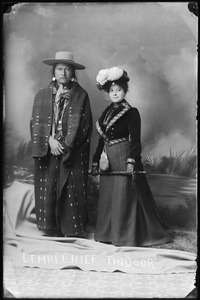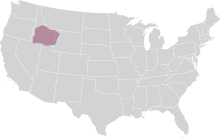Northern Shoshone
Northern Shoshone are Shoshone of the Snake River Plain of southern Idaho and the northeast of the Great Basin where Idaho, Wyoming and Utah meet. They are culturally affiliated with the Bannock people and are in the Great Basin classification of Indigenous People.
 Tindoor, chief of the Lemhi Shoshone and his wife, Idaho, ca. 1897, photograph by Benedicte Wrensted | |
| Regions with significant populations | |
|---|---|
| Languages | |
| Shoshone,[1] English | |
| Religion | |
| Native American Church, Sun Dance, traditional tribal religion,[2] Christianity, Ghost Dance | |
| Related ethnic groups | |
| other Shoshone people, Bannock |

Language
Northern Shoshone is a dialect of the Shoshone language, a Central Numic language in the Uto-Aztecan language family. It is primarily spoken on the Fort Hall and Wind River reservations in Idaho and Wyoming, respectively.[1]
Bands
Bands of Shoshone people were named for their geographic homelands and for their primary foodsources.
Mountain Shoshone bands:
- Agaideka or Agai-deka (Akaitikka, Salmon Eaters, Lemhi Shoshone, living on the middle and lower Snake River and in the Lemhi River Valley, Lemhi Range and Beaverhead Mountains in Idaho,[3][3][4] originally following the same lifeway as the Tukudeka. After acquiring horses in the eighteenth century, they adopted a Plains style and went on buffalo hunts. They were also called Kuccuntikka or Kuchun-deka (Guchundeka, Kutsindüka, Buffalo Eaters)
- Tukudeka or Tuku-deka (Tukkutikka, Dukundeka), Sheep Eaters, Mountain Sheep Eaters, living along the Salmon River, Salmon River Mountains, in the Sawtooth Valley surrounded by the Sawtooth Range, upper Payette River, in the Bitterroot Mountains and Beaverhead Mountains in Idaho, and in the Wind River Range in western Wyoming. They also traveled north toward the upper Beaverhead drainage.[5] and the upper Yellowstone River in northern Wyoming and southern Montana. The Tukkutikka bands living in the Wind River Range and the Yellowstone River region settled with the main body of Eastern Shoshone onto the Wind River Reservation in Wyoming.[6] Later the Tukkutikka bands living in the Yellowstone River region settled with the main body of Eastern Shoshone onto the Wind River Reservation.[6] The majority joined the Northern Shoshone as part of the Lemhi Shoshone.[3][4] These were also known as Doyahinee[2] (Mountain people) or Banaiti Doyanee[7](Bannock Mountaineers, because of great intermarriage with Bannock people).
Northwestern Shoshone bands:
- Kammitikka, Kamu-deka or Kamodika (Jack Rabbit Eaters, Black Tailed Rabbit Eaters, Bannock Creek Shoshone), Snake River, Great Salt Lake[3] living from a base on Bannock Creek and Arbon Valley, they claimed lands extending from Raft River to the Portneuf River and Portneuf Range in northern Utah and southern Idaho. Their territory took in part of the Fort Hall Reservation when it was established in 1867. In 1873, the three major Bannock Creek bands (Chief Pocatello, with 101 people; San Pitch, with 124; and Sagwitch, with 158) moved to the reservation at Fort Hall. A small group went to Wind River; possibly synonymous with Hukundüka or Hukan-deka (Porcupine Grass Seed Eaters, Wild Wheat Eaters).[3]
- Painkwitikka or Pengwideka (Penkwitikka, Fish Eaters, Bear Lake Shoshone), ranged from McCammon to Bear Lake along the Bear River and Logan River in the border region between Idaho and Utah, and on over to the continental divide, they lived generally north of the Cache Valley Shoshone band.
- Cache Valley Shoshone was a band of Eastern Shoshoni ranged into Idaho and Utah with their major base in Cache Valley - called in Shoshone Seuhubeogoi - ″Willow Valley″ - and on the lower reaches of Bear River not far from the later Wyoming border. They were practically wiped out at the Bear River Massacre (Battle of Bear River) (Idaho’s largest Indian battle), January 29, 1863, by Colonel P. E. Connor’s California Volunteers. Followed two months later by a similarly destructive campaign by Jefferson Standifer’s Placerville Volunteers against the Shoshone at Salmon Falls; this fight led to a series of Shoshone and Bannock treaties (Fort Bridger, July 2; Box Elder, July 30; Ruby Valley, October 1; Soda Springs, October 14) affecting Idaho, as well as the Toole Valley Band of Goshute of the Western Shoshone.
- Weber Utes, a Shoshone band farther south along the Weber River to the Great Salt Lake in Utah, because having intermarried with neighboring Cumumba Band of Utes, they speak the same dialect as the other Northwestern bands with a slight Ute accent, and were therefore usually called Weber Utes - but they speak Shoshone and are primary of Shoshone stock; were overlooked in the treaty-making process and never got a reservation, Chief Little Soldier headed the misnamed "Weber Ute" band of about 400 people.
Fort Hall Shoshone Bands:
- Boho'inee or Pohokwi (Pohogwe, Pohoini, Sage Grass people, Sagebrush Butte People,[2] which refers to Ferry Butte at Fort Hall), mixed Shoshone-Bannock band, living in southeastern Idaho on the Snake River Plain, in the Wind River Range, Salmon Falls on Snake River and wintered in the vicinity of the trading post Fort Hall, but also claimed the Camas Prairie as home, later called Fort Hall Shoshone or "Sho-Bans", also considered part of the Eastern Shoshone Bands
Western Bands of Northern Shoshone:
- Yahandeka or Yahantikka (Yakandika, Groundhog Eaters, grouped into three main geographical groupings of mixed Northern Shoshone-Northern Paiute bands):
- Boise Shoshone, among the early mounted Shoshone bands, they traveled over a considerable range by the beginning of the nineteenth century, with their main hunting lands along the lower Boise River and Payette River. When Donald MacKenzie developed the Snake country fur trade after 1818, the most prominent of the Boise Shoshone, Peiem (a Shoshoni rendition of “Big Jim”, their leader’s English name), became the most influential leader of the large composite Shoshoni band that white trappers regularly encountered in the Snake country. Peiem served as the most important Shoshone spokesman at MacKenzie’s great peace conference on Little Lost River in 1820, and figured conspicuously in Shoshone affairs when Alexander Ross and Peter Skeene Ogden led the Snake expedition later in the decade. Peiem’s son, and successor, Captain Jim, was a leader of the Boise Shoshone at the time of their removal, March 12-April 13, to the Fort Hall Reservation, which had been established for the Boise and Bruneau Shoshone, June 14, 1867, a mixed Shoshone-Northern Paiute group of Koa'aga'itöka ("Salmon Caught in Traps Eaters") of Northern Paiute and local Northern Shoshone groups.
- Bruneau Shoshone, were not organized into bands, occupied southwestern Idaho, mainly south of Snake River along the Bruneau River and from Goose Creek to Owyhee River, when the gold rush to Boise Basin brought settlers in after 1862, a mixed Shoshone-Northern Paiute group of Tagötöka/Taga Ticutta ("Root Tuber Eaters") and Wadadökadö/Wadatika (Waadadikady) ("Wada Root and Grass-seed Eaters") of Northern Paiute and local Northern Shoshone groups. After their treaty of April 12, 1866, went unratified, the Fort Hall Reservation was set aside partly for them. Later in 1877, the Duck Valley Reservation was established in their lands.
- Weiser Shoshone or Shewoki / Sohuwawki Shoshone, lived along the lower Weiser River to New Plymouth,[3][4] this country was called Shewoki, si.wo.kki?i or Su:woki - "willow-striped" or "Row of Willows" by the Shoshone, some of whom resisted placement on the Malheur Reservation, finally settled at Fort Hall and on the Duck Valley Indian Reservation, a mixed Shoshone-Northern Paiute group of Wadadökadö/Wadatika (Waadadikady) ("Wada Root and Grass-seed Eaters") and Koa'aga'itöka ("Salmon Caught in Traps Eaters") of Northern Paiute and Shoshone groups from Bruneau and Boise Rivers.
- Yahandeka or Yahantikka (Yakandika, Groundhog Eaters, grouped into three main geographical groupings of mixed Northern Shoshone-Northern Paiute bands):
Tribes and reservations
The Northern Shoshone have people who are members of three federally recognized tribes in Idaho and Utah:
- Duck Valley Indian Reservation, Idaho, for the Western Shoshone-Northern Paiute Tribe
- Shoshone-Bannock Tribes of the Fort Hall Reservation of Idaho, 544,000 acres (2,201 km²) in Idaho. Lemhi Shoshone with the Bannock Indians, a Paiute band with which they have merged.
- Lemhi Indian Reservation (1875–1907) in Idaho. This reservation was closed and the people relocated to Fort Hall Reservation, where they are counted with the Shoshone-Bannock peoples.
- Northwestern Band of the Shoshone Nation
Notes
- "Shoshoni." Ethnologue. Retrieved 20 Oct 2013.
- Loether, Christopher. "Shoshones." Encyclopedia of the Great Plains. Retrieved 20 Oct 2013.
- Murphy and Murphy 306
- Murphy and Murphy 287
- Idaho State Historical Society Reference Series: SHOSHONI AND NORTHERN PAIUTE INDIANS IN IDAHO
- DIVERSITY IN COSMOLOGY: THE CASE OF THE WIND RIVER SHOSHONI
- "Eastern Shoshone Working Dictionary" (PDF). Archived from the original (PDF) on 2014-09-12. Retrieved 2013-11-04.
References
- Murphy, Robert A. and Yolanda Murphy. "Northern Shoshone and Bannock." Warren L. d'Azevedo, volume editor. Handbook of North American Indians: Great Basin, Volume 11. Washington, DC: Smithsonian Institution, 1986: 284–307. ISBN 978-0-16-004581-3.
Further reading
- Gould, Drusilla & Loether, Christopher (2002). An introduction to the Shoshoni language: dammen da̲igwape. University of Utah Press. ISBN 9780874807295.CS1 maint: uses authors parameter (link)
- Bial Raymond. The Shoshone.
External links
| Wikimedia Commons has media related to Shoshoni. |